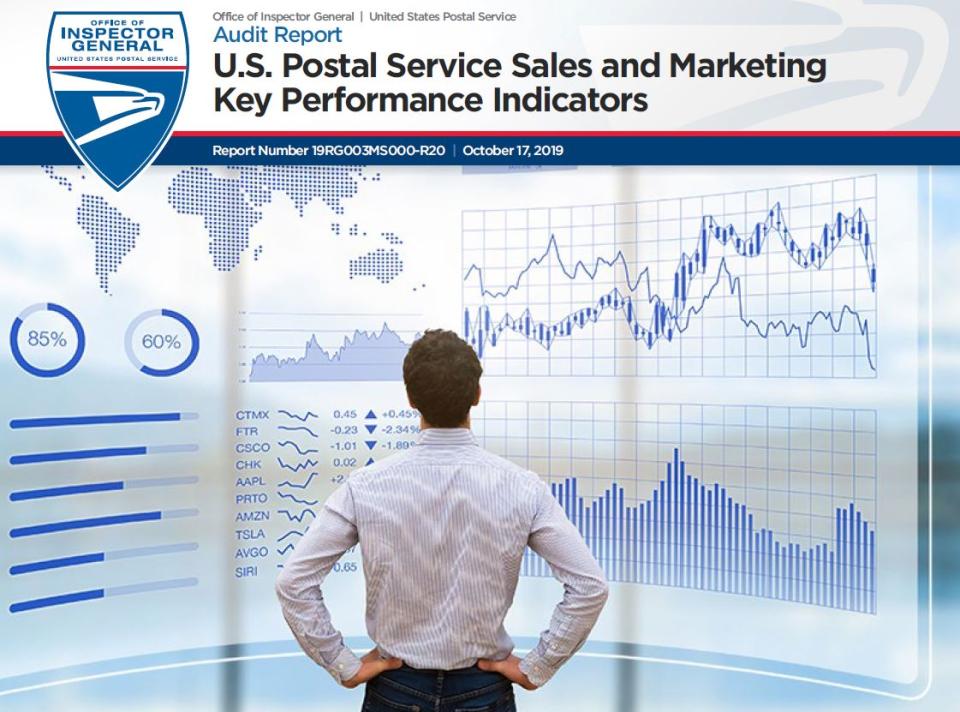U.S. Postal Service Sales and Marketing Key Performance Indicators
Objective
The objective of our audit was to identify and evaluate key performance indicators the U.S. Postal Service uses to evaluate and measure the effectiveness of its sales and marketing strategies.
The Postal Service collected $70.6 billion in revenue in fiscal year (FY) 2018 — $56.5 billion from commercial customers and $12.6 billion from its retail operations. Over the past five years revenue has been relatively stable with an overall increase of about 4 percent from FY 2014 to FY 2018. However, the Postal Service continues to operate at a loss each year, with operational costs of $74.5 billion in FY 2018, resulting in a net loss of $3.9 billion.
Between FY 2014 and FY 2018, revenue from mail products changed significantly. Revenue from packages increased 59 percent, while revenue from First-Class Mail decreased by 12 percent. This is a direct result of changing customer demands, with digital communication replacing physical correspondence, while at the same time a rapid growth in ecommerce fueled a sharp increase in package volume.
Postal Service Sales and Marketing organizations are responsible for driving new revenue and retaining existing revenue streams. Revenue is generated across multiple product and service categories and from new and established customers.
The Sales organization is managed by the acting Vice President, Sales, and has over [redacted] Sales staff nationwide. They use several metrics that support overall revenue generation, with numerous metrics that measure key performance areas. The three most significant metrics that align to the overall objective of sustaining and growing revenue include:
- Revenue: Includes total revenue, revenue by product, and other categories such as customer size. Over the last four years the top [redacted].
- New Sales: Represents new sales from small, medium, and large customers. Sales staff estimate and record the new sales amounts and management approves them. The Postal Service estimated [redacted] in revenue from new customers or new revenue streams from existing customers in FY 2018.
- Retained Revenue: Represents the amount of revenue that the Postal Service estimates its revenue retention efforts preserved or recaptured. In FY 2018, customers reduced their spending by [redacted] billion.
The Marketing organization, managed by the Vice President, Marketing, focuses on promoting Postal Service products, services, and its brand to help optimize sales and revenue. There are over [redacted] Marketing staff members nationwide spread across multiple groups, including Brand Marketing and Market Research & Insights. The Marketing organization develops and executes advertising campaigns, captures and analyzes customer sentiment, and assesses brand health. Key performance indicators for the Marketing organization include:
- Return on Advertising Spend: A measurement of the short-term value received for advertising dollars spent.
- Brand Health Trackers: Numerical scores that reflect consumer perception of both the Postal Service and its competitors, advertising effectiveness, and overall brand health based on surveys.
What the OIG Found
The Postal Service has meaningful performance indicators and useful supporting systems related to its Sales and Marketing strategies. However, we determined the Postal Service should enhance sales and marketing metrics through stronger more aggressive goals that are clearly aligned with revenue generation and retention objectives. Additionally, Marketing should independently validate contractor-generated Return on Advertising Spend and better align customer experience data sources. Specifically:
- The Postal Service should have a revenue retention metric for large customers: Over the last five years customer churn [redacted]. While the Postal Service has revenue goals for its largest accounts, it does not have an overall metric for revenue retention for their largest customers. The Postal Service planned to expand its revenue retention metric to include the top customers but had not finalized this effort.
- New sales and Revenue Retention goals should be more aggressive: The Postal Service exceeded its new sales goals and revenue retention goals over the past five years. In FY 2018, the Postal Service exceeded its new sales goal by [redacted] and its revenue retention goal by [redacted]. Given the Postal Service’s financial position, more aggressive goals could result in an overall increase in revenue.
- Return on Advertising Spend should be validated: The Postal Service lacks a process for validating its Return on Advertising Spend. Return on Advertising Spend is generated by the same contractor responsible for placing the advertisements and should be independently verified. Without independent validation, there is reduced assurance that advertising efforts are accurately and effectively measured.
- Brand Health Trackers could be better aligned with other available Postal Service customer experience data: The Postal Service could align its Brand Health Trackers with its other systems that capture customer experience, such as customer experience data from surveys and complaint data. This would allow the Postal Service to see where it can resolve issues that will have the greatest impact on customer sentiment.
What the OIG Recommended
We recommended the Acting Vice President, Sales, expand the revenue retention metric to include the top revenue generating customers and establish more aggressive new sales and revenue retention targets and develop strategies to meet those targets.
We also recommended the Vice President, Marketing, establish a process to validate contractor-generated Return on Advertising Spend and develop a process for aligning Brand Health Trackers with other available Postal Service customer experience data to increase customer satisfaction and improve overall opinion of the Postal Service brand.

